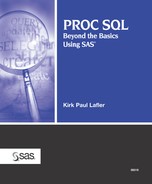5.7. Summary
Creating a table using a column-definition list is similar to defining a table’s structure with the LENGTH statement in the DATA step (see section 5.2.1).
Using the LIKE clause copies the column names and attributes from the existing table structure to the new table structure (see section 5.2.2).
Deriving a table from an existing table stores the results in a new table instead of displaying them as SAS output (see section 5.2.3).
In populating a table, three parameters are specified with an INSERT INTO statement: the name of the table, the names of the columns in which values are inserted, and the values themselves (see section 5.3.1).
Database-enforced constraints can be applied to a database table structure to enforce the type and content of data that is permitted (see section 5.4).
The DELETE statement combined with a WHERE clause selectively removes one or more rows of data from a table (see section 5.5.1).
The SQL standard permits one or more unwanted tables to be removed from a database (SAS library) (see section 5.6.2).
